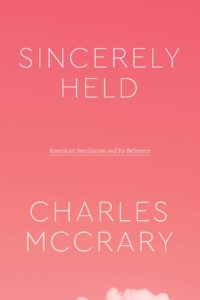
Sincerely Held: American Secularism and Its Believers
by Charles McCrary
The following material is excerpted and lightly adapted from the introduction and eighth chapter of Sincerely Held: American Secularism and Its Believers (Chicago 2022).
In 2020, legislators in Iowa introduced a bill that would define the phrase “bona fide religious purpose,” from the state’s 1965 civil rights act. The proposed bill would add a subsection explaining, “‘Bona fide religious purpose’ means any lawful purpose that furthers a sincerely held religious belief, whether or not compelled by, or central to, a system of religious belief, and without regard to the correctness, validity, or plausibility of the religious belief.” The sincere believer is an identity, a protected class whose rights are to be secured and defended. It is implicitly (and sometimes explicitly) defined against the faker. This bill was held up because opponents found it “too broad,” but it is instructive nonetheless. What does it mean to have a “sincerely held religious belief” that could be “furthered” by your actions? Who is this bill’s made-up class of persons, the sincere believer?


Sincerely Held: American Secularism and Its Believers (University of Chicago Press 2022) is a study of the character of the sincere believer. Its narrative arc, loosely tethered to a particular history of American religious freedom, shows how secular authorities have imagined religion as individual belief. In this process, religion has become unmoored from its formal institutional contexts and further internalized. In some cases, sincerely held ethical or philosophical or spiritual beliefs are in effect equal to traditionally religious ones. These developments have carried significant implications for religious freedom in the United States and elsewhere. Individuals can appeal directly to the state on their own behalf, free from strictures of a religious body but also without institutional support. When judges, for example, attempt to isolate a person’s religious belief, they inevitably read that belief through the person’s markers of identity and difference. In this way, the individual must perform in such a way as to be legible as religious and as sincere. The judge, or whoever is evaluating the religiosity of one’s belief and the sincerity with which they hold it, creates the sincere believer by reading them as such. This process of translation exposes the contours of American secularism and secularization as a disciplinary regime, even as religious freedom guarantees a widening range of rights and protections. “Sincerely held religious belief,” now central to the modern regime of American religious freedom, was produced by and within a liberal order that ensures freedoms by policing boundaries and disciplining subjects.
Swords and Shields
Throughout U.S. history, most claimants in high-profile free exercises have been religious minorities. Mormon polygamists, Jehovah’s Witnesses, members of the Native American Church, Santería practitioners, MOVE people. In many cases, these claimants were minoritized in other ways that intersected with their religious identities. I argue that religious freedom, as a liberal institution, serves to grant freedoms selectively, protecting certain dissenters while upholding normative subjectivities. From this critical perspective, “religious” has no proper or true referent and thus religious freedom is the stuff of power and politics, and its affordances will always be partial not because not “all religions” have yet to be recognized but because the process of recognizing people on the basis of their religiosity is always a technique of governance under racial liberalism. On many liberal accounts, though, the denial of the status of “religious” to minority groups is an effect of misrecognition, in which people who are really religious are mistakenly denied that status. For instance, Khyati Joshi has argued that “many religious issues come to be incorrectly labeled as racial.” In the same way, Kathryn Gin Lum and Paul Harvey write, the project of religious freedom and equality remains “incomplete,” because “when challenged, the power of the state does not recognize all ‘religion’ equally.” As time goes on, this “standard story” goes, there are setbacks here and there, but for the most part religious freedom laws ensure more freedom of expression for minorities and makes the right to free exercise accessible to more and more of them. This story charts a trajectory of uplift, of minoritized identity groups fighting for and earning rights that were rightfully theirs all along.
By the 2010s, many liberals had noticed something of a reversal. High-profile religious freedom issues often centered white Christians, not minoritized groups.
This story seemed to have been knocked off its narrative arc. By the 2010s, many liberals had noticed something of a reversal. High-profile religious freedom issues often centered white Christians, not minoritized groups. What’s more, these claimants and the organizations backing them sought to use their freedoms to do harm to more vulnerable people. Religious freedom had a new meaning. And so, many liberals began turning against religious freedom — or religious liberty, the term conservatives increasingly preferred. People for the American Way (PFAW), for example, argued in a 2015 report, “‘religious liberty’ has become an ideological rallying cry for a collection of culture warriors — and the linchpin of their legal and political strategies.” On their account, there used to be a consensus that religious freedom was a good thing. However, “that consensus has been shattered because social conservatives are trying to turn laws meant to shield individuals’ religious exercise into swords that individuals and corporations can use against antidiscrimination laws and other measures opposed by conservative religious groups.” I argue that, while certain aspects of the “new politics of religious freedom” are actually new, religious freedom has sometimes been used as a shield but has always been a sword, as scholars such as Finbarr Curtis, Tisa Wenger, Elizabeth Shakman Hurd, and Jolyon Thomas have shown. And, neither use, sword or shield, is the “correct” one; people advocate for the politics they want, and they use the tools available.

For liberal proponents of the reversal thesis, the new anti-antidiscrimination politics are taken to be a perversion of religious freedom, rather than an example of its inherent coerciveness. Journalist Katherine Stewart writes, following her discussion of the coordinated attempt by rightwing organizations to draft and pass religious freedom bills, that “at this point, it would be apparent to any listener that the agenda” of that project “had nothing to do with religious freedom in the proper sense of the term.” She continues, “By ‘religious freedom,’ participants simply meant privilege for those with the right religion.” Religious freedom becomes “religious freedom.” Stewart’s ironic quotations marks imply that there is a true referent for religious freedom, and a “proper” use of it. Stewart and her fellow critics traffic in a familiar politics of sincerity. By insinuating that discriminatory applications of religious freedom are not real religious freedom, they insinuate that religion is not really, sincerely, the motivating factor. Sometimes this is quite explicit, as in the finding by the U.S. Commission on Civil Rights that such bills and lawsuits “represent an orchestrated, nationwide effort by extremists to promote bigotry, cloaked in the mantle of ‘religious freedom’” and “are pretextual attempts to justify naked animus against lesbian, gay, bisexual, and transgender people.” It’s not religion underneath. This supposed perversion of religious freedom, according to critics like Stewart, is a new development, orchestrated by savvy operatives with a sinister agenda. Many of the claimants, though, the people to be protected by new religious freedom bills and laws—such as Mississippi’s Religious Liberty Accommodations Act or many similar local ordinances, which specifically protect those who have religious objections to the equal treatment of LGBTQ people—would say that their need for protection is new, that Christianity is under unprecedented attack, and that they simply are protecting themselves from “naked animus” against Christians, “cloaked” as the reproductive and LGBTQ rights.
This politics of sincerity and sincere belief has not led to better dialogue or public rhetoric. Instead, we have speculation about motive, insinuations about cloaks and fakery. In the meantime, an increasingly powerful Christian conservative legal movement continues to remake themselves in the form of the sincere religious believer and, more so, vice versa. It’s not the case that everyone who wins a free exercise case these days is a white conservative Christian. But, to quote Ann Pellegrini, “the successful claimant will already have internalized the pastorate and the affective codes that certify compliance with a law beyond the law.” Whether religious freedom is worth defending is an open question. Either way, though, we should understand religious freedom as a political formation, not something essential or timeless or necessarily good, that can be put to various political ends. Then, we can decide what, if anything, we want to do with it. ♦

Charles McCrary is a postdoctoral research scholar at the Center for the Study of Religion and Conflict at Arizona State University, where he works on the Templeton-funded project Beyond Secularization: Religion, Science, and Technology in Public Life. Views expressed do not necessarily represent those of the Templeton Religion Trust.
Recommended Citation
McCrary, Charles. “Excerpt from Sincerely Held: American Secularism and Its Believers.” Canopy Forum, April 8, 2022. https://canopyforum.org/2022/04/08/excerpt-from-sincerely-held-american-secularism-and-its-believers.

